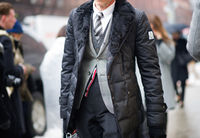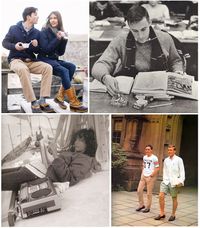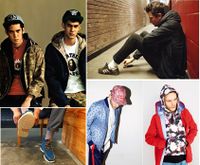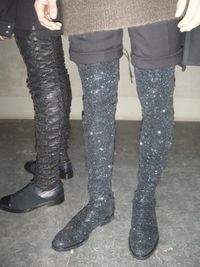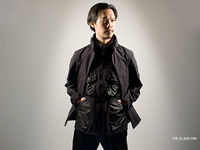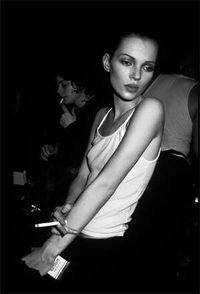Difference between revisions of "Styles"
(→Artisanal/Avant-Garde) |
(→Artisanal/Avant-Garde) |
||
| Line 59: | Line 59: | ||
[[File:1355649565428.jpg|200px|thumb|right]] | [[File:1355649565428.jpg|200px|thumb|right]] | ||
| − | Avant garde is a much less accessible, niche aesthetic | + | Avant garde is a much less accessible, niche aesthetic. The usual defining features of this style are a monochrome / grayscale color palette, unconventional proportions, textures, construction, unique materials - but really, anything goes. |
| + | |||
It is a subjective term and therefore there are no real boundaries or rules that dictate whether an unconventional "Dark" look is "Avant - Garde" or not. Ideologies and Philosophy are an important part of the aesthetic, and many of the designers make conscious efforts to differentiate themselves from mass produced garments with no meaning, depth, or "Soul". | It is a subjective term and therefore there are no real boundaries or rules that dictate whether an unconventional "Dark" look is "Avant - Garde" or not. Ideologies and Philosophy are an important part of the aesthetic, and many of the designers make conscious efforts to differentiate themselves from mass produced garments with no meaning, depth, or "Soul". | ||
| + | |||
Many pieces are made with unique techniques, treatment (dying, tanning, distressing), and materials. Often, brands place a strong focus on distinctive or unorthodox construction of pieces, for example rather than using a conventional nylon lining in a blazer, it will be unlined with raw edges on the inside, or the lining will be made of a linen/nylon blended fiber. | Many pieces are made with unique techniques, treatment (dying, tanning, distressing), and materials. Often, brands place a strong focus on distinctive or unorthodox construction of pieces, for example rather than using a conventional nylon lining in a blazer, it will be unlined with raw edges on the inside, or the lining will be made of a linen/nylon blended fiber. | ||
| + | |||
A vast majority of "avant garde" brands place a strong priority on being anti-branding, using minimalist logos on the interior of pieces, generally placing priority on the construction, form, and quality of the garment, above the brand that created it. | A vast majority of "avant garde" brands place a strong priority on being anti-branding, using minimalist logos on the interior of pieces, generally placing priority on the construction, form, and quality of the garment, above the brand that created it. | ||
| + | |||
Many of the people who appreciate this aesthetic share the same appreciation for craftsmanship, modern design, and anti - consumerism. | Many of the people who appreciate this aesthetic share the same appreciation for craftsmanship, modern design, and anti - consumerism. | ||
Revision as of 15:10, 9 August 2013
--Any information on a certain style goes here. The history of a style is also welcome.
Contents
A Small Note on Styles
If you haven't read the Introduction, then do it now. This page is for different styles, not only in fashion, but also in the life you lead. Many people disregard their day-to-day life when attempting a new style, and this is where they fail. Be concise when looking for your ideal style. Don't be a try-hard, don't be an actor.
Please Note: Categorizing fashion into "styles" like they were animals in a taxonomy, while convenient for the beginner, is actually a terrible view to adopt. Outfits cannot be "categorized" into styles completely because each one is unique, and many deviate from these supposed "styles". Styles are not objective. For more information on developing your personal style, see "Taste" in Introduction.
Traditional
Examples of Brands: Thom Browne, Tom Ford, Isaia, Brioni, Ralph Lauren Purple Label, Martin Greenfield, Calvin Klein Collection
Menswear is a modernized style that draws from conservative or classical male working aesthetic. Masculine silhouettes, formal incorporated into casual attire, and somewhat preppy styles fall here. Fit and fabric serve great importance in menswear outfits, as well as in controlling the quality of the clothing you purchase. Cheaply made, ill fitting menswear is a recipe for disaster, as it is very easy to come off as sloppy or trashy. Keeping this in mind, a crisp tailored button-down, slim-fitting trousers, a pair of casual oxfords, and a relatively casual tie, for example, can be worn to either a job interview or a night out.
In the debates that take place on /fa/ and elsewhere, styles are often given names by their opponents to mock and ridicule its followers. The derogatory term used to describe menswear is "dadcore". As the style's classical aesthetic is associated with the older generations (as in being "clothes for dads") menswear has been mocked as such. However, the nickname has since turned into the term used for failed attempts at menswear which include fedoras, ill fitted suits and generally horrid taste.
Clothing in this type of style highly emphasizes construction, material quality and the difficult pattern-making work. Such examples include Loro Piana who is known for cashmere, Ermenegildo Zegna for their wool, and bespoke labels.
Prep
Examples of Brands: J Press, Brooks Brothers, J Crew, Polo Ralph Lauren, Lacoste
Similar in some ways to traditional menswear, but with key distinctions, "prep" is a style that evolved on Ivy League campuses in the mid twentieth century and came to exemplify New England's white upper middle class. Given the influence of collegiate and prep school environments had in shaping the style, prep modes of dress are more casual, youthful, and sporting in nature than traditional menswear. Prep clothing pays homage to upper middle class leisure activities like equestrianism, sailing, yachting, hunting, rowing, lacrosse, tennis, and rugby. Many prep essentials, in fact, originated as sportswear like the canvas tennis sneaker, the polo, and the waxed hunting jacket. Embroidered pants may feature nautical symbols, ducks, or hounds. Nautical stripes and boat shoes hearken to sailing as well as the historical significance of fishing to the region.
As a result of this, women's prep styles will often appear androgynous, forgoing skirts and adopting pants, shorts, crew neck sweaters and men's button downs.
Prep Essentials: white trainers (canvas or otherwise), wool crew neck sweaters, striped sweaters, chinos, braided leather belts, boat shoes and loafers, a sportscoat, polos, oxfords (both the shoe and the shirt), madras, tweed, duck boots.
Streetwear
Examples of Brands: Supreme, White Mountaineering, Bape, Undercover, WTAPS, Visvim, Stussy, Norse Projects, RSVP
Streetwear is a style with roots in Western American surf and skate culture but has grown to take inspiration from everything from rap culture, Japanese street fashion, techwear, and even workwear brands. While it has evolved over the years, there are certain clothing items and designs that characterize the style such as bold all over prints, five panel hats, beanies, athletic sneakers (often in loud colorways), brand display, and outerwear made predominantly of synthetic fabrics.
Despite these defining features, streetwear is considered one of the more flexible and approachable styles given its emphasis on steeze. The two major forums dedicated to streetwear are Hypebeast and superfuture.
Artisanal/Avant-Garde
Examples of Brands: Rick Owens, Yohji Yamamoto, Julius_7, Ann Demeulemeester, Maison Martin Margiela, Rad Hourani.
Avant garde is a much less accessible, niche aesthetic. The usual defining features of this style are a monochrome / grayscale color palette, unconventional proportions, textures, construction, unique materials - but really, anything goes.
It is a subjective term and therefore there are no real boundaries or rules that dictate whether an unconventional "Dark" look is "Avant - Garde" or not. Ideologies and Philosophy are an important part of the aesthetic, and many of the designers make conscious efforts to differentiate themselves from mass produced garments with no meaning, depth, or "Soul".
Many pieces are made with unique techniques, treatment (dying, tanning, distressing), and materials. Often, brands place a strong focus on distinctive or unorthodox construction of pieces, for example rather than using a conventional nylon lining in a blazer, it will be unlined with raw edges on the inside, or the lining will be made of a linen/nylon blended fiber.
A vast majority of "avant garde" brands place a strong priority on being anti-branding, using minimalist logos on the interior of pieces, generally placing priority on the construction, form, and quality of the garment, above the brand that created it.
Many of the people who appreciate this aesthetic share the same appreciation for craftsmanship, modern design, and anti - consumerism.
Urban Techwear
Examples of Brands: Acronym, Arc'teryx Veilance, Y-3, Gyakusou, Isaora, Outlier
Clothing designed to have specific functional properties incorporating new fabrics and technologies, but worn as everyday clothing. Many brands that exemplify this style are the result of collaborations between fashion designers and sportswear brands (e.g., Y-3, Gyakusou).
Some of the clothing takes design cues from military garments (starting with Christopher Bailey's reintroduction of the military inspired aesthetic).
Other techwear designs feature clothing with a streamlined, technical look. At some points similar to streetwear, but with a emphasis on human interaction with the elements through technology. Smart fabrics, digital gadgets and the like are coupled with the clothes themselves making many fit for outdoor activities as well.
Heroin Chic
Examples of Brands: Yves Saint Laurent Rive Gauche (Hedi Era), Dior Homme (Hedi Era), Saint Laurent Paris (also Hedi Era)
More of a "look" than a style of dress, heroin chic became popular in the 90's starting with a Calvin Klein runway show featuring Kate Moss and a series of Vincent Gallo photos featuring emaciated, pale, drug-addicted looking models. Heroin prices were dropping and the purity was much better at the time, which helped increase its popularity.
The style was dead in the magazines when, Gisele Bundchen was dubbed the new supermodel in 1999. Nowadays, though, it carries on in fashion with a much lighter tone thanks to our teenagers who insist on dying due to anorexia which, as a result, places Heroin Chic in poor light.
